
Use your existing Word and PDF templates for generating business documents such as proposals, letters, invoices, etc.
- No separate designer/add-on for template creation. Use existing MS Word or PDF templates as-is.
-
Generate documents by populating data from
- SQL Server, Oracle, MySQL, MongoDB, etc. databases.
- Enterprise applications such as Salesforce, Workday.
- XML/JSON/Excel data.
- The system auto-generates fillable forms from templates. Internal and external users can fill these forms to generate documents.
- Generate documents in PDF, Word, HTML, or Image format.
- You can download generate documents or distribute them through various channels including email, print, sync to cloud storage, and E-Sign.

The system is business-user friendly. Follow these steps for document generation and distribution.
STEP 1: Upload Existing Template
EDocGen supports the dynamic population of text, tables, images, paragraphs, hyperlinks, reusable content blocks, etc. Each one has a distinct tag. Just add the relevant tags to existing templates. Business users can edit their templates in the native editors. For example, Word templates can be edited in Microsoft Word. For more details on tag notations, check the help guide.
Word and PDF Template Upload: Upload DOCX/PDF templates by clicking the 'Upload a template' button at the right-top on the Template screen. It opens a pop-up to drag-and-drop/select the template from the local machine.
Permissions: You can also select which roles can access this template. Only authorized personnel can create documents from this template.
Folders: While uploading a template, you can choose the folder for that template.
STEP 2: Data to Documents
After uploading your template into the EDocGen document generator, now it's time to generate documents from it. The tool offers several options to automate document generation.
XML/JSON/Excel: The population of Exel/XML/JSON is a three-step process. In the first step, upload the file. In the second step map the template dynamic fields to data headers. Finally, in the third step, enter the file name. You can choose to prefix the file name with one of the dynamic field values for easy identification of files.
Form Input: The webform option has two steps. In the first step, input the dynamic values in the form. In the second step, enter the file name and click generate. The fillable form is suited for creating a single document. You can share the form URL and "invite" your customers and vendors to fill it.
Databases: Document generation from Databases is a three-step. The webform option has two steps. In the first step, input the connection string and the SQL query. In the second step map the template dynamic fields to column names. Finally, in the third step, enter the file name.
STEP 3: Document Distribution
Email: The system auto-sends generated documents to the contact email present on the respective documents. You can configure to send them from your business email using SendGrid, Office 365, GSuite, and SES.
E-Sign: The E-Sign framework allows you to send generated documents to the E-Sign provider of choice.
Cloud Storage: Sync generated documents to cloud storage providers such as OneDrive, SharePoint, etc.,
Print: Generates a single print-ready file.
Key Features
Text and Tables

Text and tables can be merged into documents wherever a tag is placed. The system supports the multi-lingual data population.
Images

Populate images into the templates from the data file. You can dynamically set the image size. The system also supports the Base64 image population.
Numerical calculations

Perform the sum, multiplication, average, etc. of a set of values inline when the document is generated. For example, if you want to calculate the total invoice amount in an invoice table, add the sum to the table. The value would be computed at the time of generation.
The system also supports the dynamic population of hyperlinks, content blocks, file attachments, HTML, etc.
EDocGen Document Generator API
It is the best solution for fast, accurate, and secure document creation. It is hosted on Google Cloud Platform and all documents generated by the software are protected with strong encryption and authentication. All data files get deleted after document generation.
Integrate with REST API for automating document generation and distribution.
Excel: Say goodbye to tedious limited functionality mail merge. Merge vertical & horizontal orientation of excel data, many to one mail merge, multiple tables, dynamic images, content blocks into document templates
XML: XML is the universal standard for data interchange and often you find a need to merge XML data into Word/PDF document template. It is the easiest way to merge your XML data into the document template
JSON: Almost all databases allow you to export database data in JSON format. It is the perfect solution to auto-fill JSON data into document templates.
Web-Forms: EDocGen auto-generates fillable form from PDF and word template for entering dynamic fields’ values. Filling documents through this approach improves productivity by 70-80%. Fill it once, and the system populates all multiple occurrences of any field in the document. There is also an option to save it as a draft.
Say goodbye to typos, misplaced or lost information, and blank fields. EDocGen online document generator is built to make sure you produce precise and pristine documents every single time. Register to see the document generator in action.